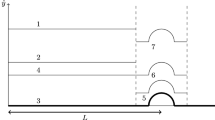Summary
In this work perturbation techniques are used to study the problem of the interaction between a shock wave and a transpired turbulent boundary layer at transonic speeds. In the case considered here, the Mach number is assumed to be high enough for the sonic line to penetrate deep into the boundary layer so that it ends close to the wall. The flow region is divided into a region of strong interaction and regions of weak interaction. For the regions of weak interaction, upstream and downstream of the shock, a classical two-deck structure is assumed to hold for the boundary layer. Solutions chosen for these regions must account for the effects of blowing or suction. The strong interaction region on the other hand is shown to consist of three decks. A detailed analysis of the whole flow field is carried out and solutions valid in the double limit as Reynolds number tends to infinity and Mach number tends to one are proposed. Solutions of adjacent layers are shown to match so providing a smooth solution for the entire flow region. The analysis yields solutions for the pressure and skin-friction profiles.
Zusammenfassung
In dieser Veröffentlichung wird mit Methoden der Störungsrechnung das Problem der Wechselwirkung zwischen einer Schockwelle und einer turbulenten Grenzschicht mit Blas- und Saugeffekten beim Übergang zu Überschallgeschwindigkeiten untersucht. In dem hier betrachteten Fall ist die Machzahl so hoch, daß die Schockwellenfront tief in die Grenzschicht eindringt und nahe bei der Wand endet. Das Strömungsgebiet wird in ein Gebiet starker Wechselwirkung und in ein Gebiet schwacher Wechselwirkung eingeteilt. Für die Gebiete schwacher Wechselwirkung (vor und hinter der Schockwellenfront) wird angenommen, daß die Grenzschicht eine klassische zwei-Deck Struktur besitzt. Lösungen, die für diese Gebiete gewählt werden, müssen die Blas- oder Saugeffekte erklären. Es wird gezeigt, daß das Gebiet starker Wechselwirkung dagegen aus drei Decks besteht. Eine ausführliche Berechnung des gesamten Strömungsfeldes wird durchgeführt, und es werden Lösungen angegeben, die gültig sind für den doppelten Grenzfall, daß die Reynoldszahl gegen unendlich und die Machzahl gegen eins strebt. Es zeigt sich, daß die Lösungen für benachbarte Schichten aneinander passen, und daß sich damit eine stetige Lösung für das gesamte Strömungsgebiet ergibt. Die Lösungen für die Druck- und Wandreibungsprofile werden bestimmt.
Similar content being viewed by others
References
P. Krogmann, E. Stanewsky and P. Thiede,Effects of suction on shock /boundary layer interaction and shock induced separation. J. Aircraft22, 37–42 (1985).
H. T. Nagamatsu, R. D. Orozco and D. C. Ling,Porosity effects on supercritical airfoil drag reduction by shock wave/boundary layer control. AIAA paper No. 84-1682 (1984).
H. T. Nagamatsu, R. V. Ficarra and R. Dyer,Supercritical airfoil drag reduction by passive shock wave/boundary layer control in the Mach number range 0.75 to 0.90. AIAA paper No. 85-0207 (1985).
C. R. Oiling and G. S. Kulikravich,Porous aerofoil analysis using viscous-inviscid coupling at transonic speeds. Int. J. Num. Meth. in Fluids7, 103–121 (1987).
G. Savu, O. Trifu and L. Z. Dumitrescu,Supression of shocks on transonic aerofoils. 14th Int. Symp. on Shock Tubes and Waves, 92–101 (1983).
A. F. Messiter,Interaction between a normal shock wave and a turbulent boundary layer at high transonic speeds. Part I: Pressure distribution, ZAMP31, 204–227 (1980).
M. S. Liou and T. C. Adamson, Jr.,Interaction between a normal shock wave and a turbulent boundary layer at high transonic speeds. Part II: Wall Shear stress, ZAMP31, 227–246 (1980).
A. P. Silva-Freire,An asymptotic solution for transpired incompressible turbulent boundary layers. To be published in the Int. J. Heat & Mass Transfer.
A. P. Silva-Freire,An extension of the transpired skin-friction equation to compressible turbulent boundary layers. To be published.
R. L. Simpson,Characteristics of turbulent boundary layers at low Reynolds numbers with and without transpiration. JFM42, 769–802 (1970).
T. N. Stevenson,A modified defect law for turbulent boundary layers with suction or injection. Cranfield College of Aero, Aero report No.170 (1963).
T. C. Adamson, Jr. and A. F. Messiter,Normal shock wave-turbulent boundary layer interactions in transonic flow near separation, Transonic flow problems in turbomachinery. Ed. T. C. Adamson Jr. and M. F. Platzer, 392–441 (1977).
T. C. Adamson, Jr. and A. Feo,Interaction between a shock wave and a turbulent boundary layer at transonic speeds, SIAM J. Appl. Math.29, 121–145 (1975).
G. E. Gadd,Interactions between shock waves and turbulent boundary layers, ARC R & M 3262 (1961).
W. G. Sawyer and C. J. Long,A study of normal shock-wave turbulent boundary layer interaction at Mach numbers 1.3, 1.4 and 1.5, RAE TR No. 82099 (1982).
Author information
Authors and Affiliations
Rights and permissions
About this article
Cite this article
Silva-Freire, A.P. An asymptotic approach for shock-wave/transpired turbulent boundary layer interactions. Z. angew. Math. Phys. 39, 478–503 (1988). https://doi.org/10.1007/BF00948959
Received:
Published:
Issue Date:
DOI: https://doi.org/10.1007/BF00948959




